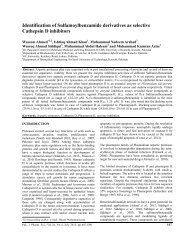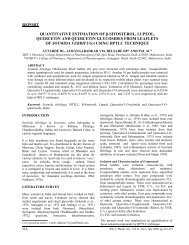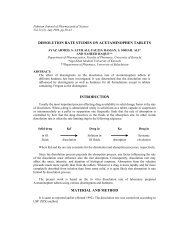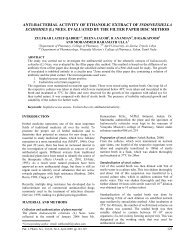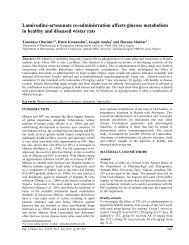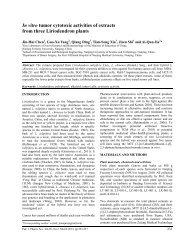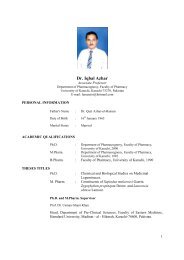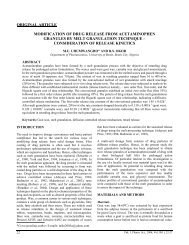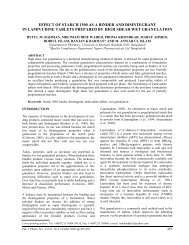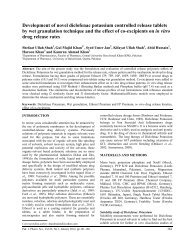View Complete Article
View Complete Article
View Complete Article
Create successful ePaper yourself
Turn your PDF publications into a flip-book with our unique Google optimized e-Paper software.
PREVENTION OF CCL4-INDUCED OXIDATIVE DAMAGE<br />
IN ADRENAL GLAND BY DIGERA MURICATA EXTRACT IN RAT<br />
MUHAMMAD RASHID KHAN* AND TAHIRA YOUNUS<br />
Department of Biochemistry, Faculty of Biological Sciences,<br />
Quaid-i-Azam University, Islamabad, Pakistan<br />
ABSTRACT<br />
Digera muricata (L.) Mart. is a weed and commonly found in waste places, road sides and in maize fields<br />
during the summer season. It possesses antioxidant capacity and is locally used for various disorders such as<br />
inflammation, urination, as refrigerant, aperient and in sexual anomalies.<br />
In this study antioxidant potential of Digera muricata methanol extract (DMME) and n-hexane extract (DMHE)<br />
was evaluated against CCl4-induced oxidative stress in adrenal gland of Sprague-Dawley male rats. 42 rats were<br />
equally divided into 7 groups of 6 rats in each. Group I remained untreated, while Group II treated with<br />
vehicles. Group III received only CCl4 (1 ml/kg b.w., 10% in olive oil) once a week for 16 weeks. Group IV and<br />
VI received DMME and DMHE at a dose of 200 mg/kg b.w. along with CCl4. Animals of Group V and VII<br />
administered with DMME and DMHE alone at a dose of 200 mg/kg b.w. once a week for 16 weeks.<br />
Lipid peroxidation significantly increased while activities of antioxidant enzymes (CAT, SOD, GST, GSR and<br />
GSH-Px) were reduced in adrenal gland samples by the administration of CCl4. Glutathione (GSH)<br />
concentration was significantly decreased whereas DNA fragmentation% and AgNORs count was increased in<br />
adrenal gland by CCl4 administration. Treatment of rat by both the extracts (DMME, DMHE) and CCl4<br />
increased the glutathione level and activities of antioxidant enzymes while reduced the lipid peroxidation, DNA<br />
fragmentation percent and AgNORs count in adrenal gland.<br />
These results indicate that Digera muricata extract is able to ameliorate oxidative stress in adrenal gland<br />
induced by CCl4 in rat.<br />
Keywords: Digera muricata, carbon tetrachloride, adrenal gland, antioxidant enzymes.<br />
INTRODUCTION<br />
Carbon tetrachloride (CCl4) is known to induce damage in<br />
liver, lungs, kidneys, adrenals and central nervous system<br />
in humans and experimental animals (Rechnagel et al.,<br />
1989). The initial step in the tissue injury induced by<br />
carbon tetrachloride is its cytochrome P450-mediated<br />
formation of trichloromethyl radical (•CCl3) and<br />
trichloromethyl peroxyl (•CCl3OO.) free radical (Slater,<br />
1984; Halliwell and Gutteridge, 2007). With respect to its<br />
molecular characteristics CCl4 does induce oxidative<br />
stress with the production of free peroxy radicals and<br />
lipoperoxides thereby damaging proteins, DNA and<br />
lipids.<br />
The adrenal gland is exquisitely sensitive to toxic assault.<br />
It has been reported that the most frequently observed site<br />
of endocrine lesion is the adrenal gland (Ribelin, 1984;<br />
Harvey, 1999). There are two features of the adrenal<br />
gland which make it vulnerable to toxic assault (Hinson<br />
and Raven, 1999). It is a discrete gland and its high<br />
vascularity, facilitates the delivery of toxins and<br />
metabolic substrates as well as the efficient removal of<br />
steroid products (Vinson and Hinson, 1992). The adrenal<br />
has a high capacity for lipid peroxidation, which is<br />
implicated in the toxic effects of carbon tetrachloride on<br />
this tissue (Brogan et al., 1984).<br />
*Corresponding author: e-mail: mrkhanqau@yahoo.com<br />
Endogenous antioxidants such as polyphenolic<br />
compounds, ascorbic acid and monosaccharides in<br />
medicinal plants may constitute antioxidative defense by<br />
scavenging free radicals possibly increase the longevity of<br />
biological systems (Khan and Ahmed, 2009). Chemical<br />
characterization of Digera muricata indicated the<br />
presence of flavonoids, tannins, alkaloids, saponins,<br />
phenols, and terpenes (Mathad and Meti, 2010). Rutin and<br />
hyperoside flavonoids have been identified in this plant.<br />
Antioxidant properties of Digera muricata methanol<br />
extract against the CCl4-induced toxicity in kidneys and<br />
testis had been well documented (Khan et al., 2009; Khan<br />
and Ahmed, 2009). Alterations induced with CCl4 in<br />
kidneys were suppressed with Digera muricata, as were<br />
evident by the higher activities of antioxidant enzymes<br />
while lower concentration of lipid peroxides. It also<br />
inhibited the genotoxicity and suppressed the activity of<br />
telomerase enzyme induced with CCl4 in kidneys of rat<br />
(Khan et al., 2009). Similarly, its protective effects<br />
against the CCl4 induced liver and testiculat toxicity have<br />
been characterized (Khan and Ahmed, 2009). Digera<br />
muricata restored the disruptions induced with CCl4 for<br />
various male hormones in rat (Khan and Ahmed, 2009).<br />
This plant is used as an alternative in secondary infertility<br />
(Chettleborough et al., 2000). In Pakistan, Digera<br />
muricata is used as an alternative in the treatment of renal<br />
disorders (Anjaria et al., 2002; Khan et al., 2009),<br />
aperient, and refrigerant (Hocking, 1962) and in sexual<br />
Pak. J. Pharm. Sci., Vol.24, No.4, October 2011, pp.469-473 469
Prevention of CCL4-induced oxidative damage<br />
disorders (Khan and Ahmed, 2009). Antimicrobial<br />
activity of Digera muricata had been well documented<br />
(Mathad and Meti, 2010). This study was carried out to<br />
evaluate the protective effects of Digera muricata (L.)<br />
Mart. methanol and n-hexane extracts against CCl4<br />
induced adrenal toxicity. The main objectives were to<br />
determine the changes in antioxidant enzymes, lipid<br />
peroxidation, antioxidant enzymes and glutathione,<br />
argyrophilic nucleolar organizer regions (AgNORs)<br />
changes, and to determine the effects on genomic DNA of<br />
adrenal gland of rat.<br />
MATERIALS AND METHODS<br />
Preparation of plant extract<br />
Digera muricata (L.) Mart. locally named as “Tandla” at<br />
maturity were collected from the campus of Quaid-i-<br />
Azam University Islamabad during July 2006. After<br />
identification a voucher specimen (125127) was deposited<br />
in the Herbarium of Pakistan at Quaid-i-Azam University<br />
Islamabad, Pakistan.<br />
Aerial parts were shade dried for two weeks and<br />
powdered in a Willy Mill to 60-mesh size. Briefly, 750 g<br />
powder was extracted separately with 5 litres of methanol<br />
and n-hexane at 25 °C for a week. After extraction the<br />
mixture was filtered, methanol and n-hexane solution was<br />
evaporated in a rotary evaporator (Panchun Scientific Co.,<br />
Kaohsiung, Taiwan) at 40 °C and stored at 4 ºC. Methanol<br />
extraction yielded 19 g while n-hexane extraction gave 7<br />
g of extract.<br />
Animals and treatment<br />
Forty two healthy Sprague-Dawley male rats, weighing<br />
250±10g, were provided by the Animal House of National<br />
Institute of Health (NIH) Islamabad and were maintained<br />
at the Primate Facility at Quaid-i-Azam University,<br />
Islamabad. Food and fresh water was available to the rats.<br />
Animals were equally divided into seven groups with 6<br />
animals in each. Group I was control, group II was treated<br />
with olive oil (1 ml/kg b.w., i.p.) followed by DMSO (1<br />
ml/kg b.w., intragastric) once a week for 16 weeks. Group<br />
III was injected intraperitoneally once a week for 16<br />
weeks with CCl4 (1 ml/kg b.w., 10% in olve oil). Group<br />
IV and V were treated both with CCl4 and the extracts<br />
(DMME; DMHE; 200 mg/kg b.w., intragastric). Group<br />
VI and VII were treated with the extracts (DMME;<br />
DMHE 200 mg/kg b.w., intragastric) only. Both the<br />
extracts were administered once a week for 16 weeks.<br />
At the end of 16 weeks, 24 h of the last treatment, all the<br />
animals were anesthesized in an ether chamber. Blood<br />
was collected by cardiac puncture and serum obtained by<br />
blood centrifugation at 1500 × g for 10 min, at 4 °C. The<br />
adrenal gland was removed after perfusion with ice cold<br />
saline at 4°C. Half of the adrenal gland was stored at<br />
-70°C to study the DNA damages, and biochemical<br />
470<br />
parameters while the other portion was processed for the<br />
AgNORs count.<br />
Assessment of antioxidant enzymes<br />
Adrenal gland samples were centrifuged at 12,000 × g for<br />
30 min at 4 o C after homogenizing in 10 volume of<br />
phosphate buffer; 100 mM KH2PO4, 1 mM EDTA (pH<br />
7.4). The supernatant obtained was used for the estimation<br />
of activity level of different enzymes and the endogenous<br />
glutathione and lipid peroxidation concentration.<br />
To estimate the catalase (CAT) activity in adrenal gland<br />
hydrogen peroxide as substrate was used according to the<br />
method of Chance and Maehly (1955). Activity level of<br />
superoxide dismutase (SOD) was determined according to<br />
Kakkar et al. (1984) method. Glutathione-S-transferase<br />
(GST) activity was estimated according to Habig et al.<br />
(1974) procedure. Assay of glutathione reductase (GSR)<br />
activity was carried out according to Carlberg and<br />
Mannervik (1975). However, glutathione peroxidase<br />
(GSH-Px) activity level was estimated by using the<br />
method of Mohandas et al. (1984).<br />
Reduced glutathione (GSH) and lipid peroxidation assay<br />
Endogenous level of reduced glutathione (GSH) was find<br />
out by following Jollow et al. (1974) method whereas<br />
method of Iqbal et al. (1996) was used to determine the<br />
lipid peroxidation by measuring malondialdehyde (MDA)<br />
contents in adrenal gland.<br />
DNA fragmentation percent assay<br />
In adrenal gland samples DNA fragmentation was<br />
determined according to Wu et al. (2005) method.<br />
Briefly, adrenal gland (50 mg) was homogenized in TE<br />
buffer (pH 8; 5 mM Tris HCl and 8 mM EDTA) and 0.2%<br />
triton X-100 and centrifuged at 27,000 × g for 20 min.<br />
Intact chromatin was obtained as pellet B while<br />
fragmented DNA was obtained as supernatant T. Both B<br />
and T were used to estimate the DNA by using<br />
diphenylamine solution and optical density was measured<br />
at 620 nm. The results were expressed as amount of %<br />
fragmented DNA by the following formula:<br />
% fragmented DNA = T×100/(T+B)<br />
Argyrophilic Nucleolar Organizer’s Region (AgNORs)<br />
count<br />
Nucleoli were silver stained according to the technique of<br />
Trere et al. (1996). Fixed slides were dewaxed in xylene<br />
and after hydration in descending order of ethanol<br />
concentration (90, 70 and 50%) were washed for 10 min<br />
in distilled water and dried. Slides were incubated at 35ºC<br />
for about 8-12 min after addition of one drop of colloidal<br />
solution (2% gelatin; 1% formic acid) and two drops of<br />
50% AgNO3 solution. Reaction was stopped by washing<br />
in distilled water and 1% sodium thiosulphate (1 min) to<br />
get golden colored nuclei and brown/black NORs. Slides<br />
were examined under microscope to count the number of<br />
AgNORs per cell.<br />
Pak. J. Pharm. Sci., Vol.24, No.4, October 2011, pp.469-473
STATISTICAL ANALYSIS<br />
Mean and standard deviation (SD) of the data was<br />
determined. One way analysis of variance was applied<br />
and post hoc comparison in terms of least significance<br />
difference (LSD) at 0.05, 0.01 and 0.001 was used to<br />
analyze the difference among various treatments by using<br />
the Microsoft SPSS Ver. 14.0.<br />
RESULTS<br />
Effect of DMME and DMHE on antioxidant enzymes<br />
Activity levels of CAT, SOD, GSH-Px, GST and GSR<br />
were significantly (p < 0.001) lowered in adrenal gland<br />
samples of CCl4 treated group compared with control<br />
group (table 1). Administration of DMME and DMHE to<br />
rats along with CCl4 ameliorated the oxidative stress<br />
induced with CCl4 and increased the activities of<br />
antioxidant enzymes; CAT, SOD, GSH-Px, GST and<br />
GSR in adrenal gland samples compared with the group<br />
given CCl4 only. DMME and DMHE administration alone<br />
did not significantly change the activity levels of CAT,<br />
SOD, GSH-Px, GST and GSR in adrenal gland samples<br />
when compared with controls.<br />
Effect of DMME and DMHE on glutathione, lipid<br />
peroxidation, AgNORs count and DNA fragmentation<br />
Carbon tetrachloride treatment to rats significantly<br />
(p
Prevention of CCL4-induced oxidative damage<br />
hydrogen peroxide and lipoperoxides by the GSH-Px<br />
family during which GSH is converted into oxidized form<br />
of glutathione (GSSG). Oxidized glutathione is converted<br />
back into GSH by another rate controlling enzyme the<br />
glutathione reductase (GSR) thereby maintain the<br />
intracellular GSH levels. This optimum level of GSH is<br />
an utmost criterion in maintaining the structural integrity<br />
and physiology of cell membranes. Another<br />
multifunctional antioxidant enzyme of the redox cycle;<br />
glutathione-S-transferase plays a key role as a<br />
thioltransferase-like redox regulator of hydrophobic<br />
compounds (Sheweita et al., 2001).<br />
CCl4-intoxication to rats in this experiment evidently<br />
induces decline in the activity of antioxidant enzymes<br />
(CAT, SOD, GSH-Px, GSR, GST) suggesting severe<br />
oxidative injuries to adrenal gland. Determination of<br />
activity level of these antioxidant enzymes is an<br />
appropriate indirect way to assess the pro-oxidant<br />
antioxidant status in tissues (Halliwell and Gutteridge,<br />
2007; Priscilla and Prince, 2009).<br />
GSH along with other endogenous antioxidants such as<br />
ascorbic acid and α-tocopherol plays a central role in<br />
eliminating free radicals and other reactive species.<br />
Antioxidant activities of GSH are mainly attributed to its<br />
side chain sulfhydryl (-SH) residue. The treatment of<br />
DMME and DMHE are able to restore the level of<br />
antioxidant enzymes such as CAT, SOD, GST, GSR and<br />
GSH-Px which are decreased in CCl4 treated group. The<br />
protective effects of DMME and DMHE in maintaining<br />
the GSH level towards control have increased the capacity<br />
of endogenous antioxidant defense and increased the<br />
steady state of GSH and/ or its rate of synthesis that<br />
confers enhanced protection against oxidative stress<br />
(Khan and Ahmed, 2009; Khan et al., 2009).<br />
Metabolites of CCl4 such as trichloromethyl radical<br />
(•CCl3) and trichloromethylperoxyl (•CCl3OO.) are the<br />
major free radicals (Slater, 1984; Halliwell and<br />
Gutteridge, 2007) which cause oxidative stress and lipid<br />
peroxidation of polyunsaturated fatty acids. It has been<br />
hypothesized that our plant extracts afford protection by<br />
impairing CCl4 mediated lipid peroxidation, through<br />
amelioration of oxidative stress, as evident from the<br />
alleviated malondialdehyde (MDA) level. The group<br />
treated with CCl4 only is more vulnerable to oxidative<br />
injuries and thereby high lipid peroxidation, whereas the<br />
group received the co-administration of DMME and<br />
DMHE exhibited significant protection. These results<br />
indicated the antioxidant potential of DMME and DMHE<br />
against the reactive oxygen species generated by the<br />
metabolic conversion of CCl4. Similar testicular and<br />
nephroprotective effects of Digera muricata are also<br />
reported (Khan and Ahmed, 2009; Khan et al., 2009).<br />
Administration of CCl4 causes DNA damages as evident<br />
by the higher level of DNA fragmentation percentage<br />
472<br />
(Weber et al., 2003; Khan et al., 2009; Khan et al., 2010).<br />
However, DNA fragmentation induced by CCl4 was<br />
restored by the DMME and DMHE treatment.<br />
Nucleolar organizer regions (NORs) are the areas of<br />
secondary constriction and are primarily involved in the<br />
synthesis of ribosomal RNA (rRNA). Chemically these<br />
sites are characterized of ribosomal DNA (rDNA) and<br />
non-histone proteins having high affinity for silver (Trere<br />
et al., 1996). Treatment of CCl4 to rats induces<br />
genotoxicity by increasing the number of nucleoli (NORs)<br />
(Bocking et al., 2001; Khanna et al., 2001; Khan et al.,<br />
2009) and structural deformities in adrenal gland samples<br />
to complement other oxidative injuries. Supplement of<br />
DMME and DMHE to rats ameliorated the genotoxicity<br />
on AgNORs and revert the AgNORs count towards the<br />
control group in conformity to other studies (Khan et al.,<br />
2009).<br />
CONCLUSION<br />
It is envisaged from the present investigation that the<br />
altered antioxidant profile, glutathione, lipid peroxidation,<br />
DNA fragmentation percent and AgNORs count due to<br />
CCl4 exposure is reversed towards normalization by<br />
DMME and DMHE. These results suggest that there are<br />
some active compounds present in the plant extracts<br />
which are responsible for the observed antioxidant<br />
activity. Further studies are required to isolate and<br />
characterize the active compounds responsible for<br />
antioxidant effects.<br />
REFERENCES<br />
Anjaria J, Parabia M, Bhatt G and Khamar R (2002). A<br />
glossary of selected indigenous medicinal plants of<br />
India. SRISTI Innovations PO Box: 15050,<br />
Ahmedabad-380 015, India p.26.<br />
Bocking A, Motherby H, Rohn BL, Bucksteege B, Knops<br />
K and Pomjanski N (2001). Early diagnosis of<br />
mesothelioma in serous effusions using AgNOR<br />
analysis. Ana. Quant. Cytol. Histol., 23: 151-160.<br />
Brogan WC, Eacho PI, Hinton DE, and Colby HD (1984).<br />
Effects of carbon tetrachloride on adrenocortical<br />
structure and function in guinea pigs. Toxicol. Appl.<br />
Pharmacol., 75: 118-127.<br />
Carlberg I and Mannervik EB (1975). Glutathione level in<br />
rat brain. J. Biol. Chem., 250: 4475-4480.<br />
Chance B and Maechly C (1955). Assay of catalase and<br />
peroxidases. Method Enzymol., 11: 764-775.<br />
Chettleborough J, Lumeta J and Magesea S (2000).<br />
Community use of nontimber forest products: A case<br />
study for the Kilombero valley. Integrated<br />
Environmental Programme. The Society for<br />
Environmental Exploration UK and the University of<br />
Da es Salaam. Frontier Tazania, p.16<br />
Pak. J. Pharm. Sci., Vol.24, No.4, October 2011, pp.469-473
Habig WH, Pabst MJ and Jakoby WB (1974).<br />
Glutathione-S-transferases: the first enzymatic step in<br />
mercapturic acid formation. J. Biol. Chem., 249: 7130-<br />
7139.<br />
Halliwell B and Gutteridge JMC (2007). Cellular<br />
responses to oxidative stress: adaptation, damage,<br />
repair, senescence and death. In: Free radicals in<br />
biology and medicine, Oxford University Press Inc.,<br />
Oxford, pp.187-267.<br />
Harvey PW (1999). An overview of adrenal gland<br />
involvement in toxicology. In: Harvey PW (ed.). The<br />
Adrenal in Toxicology. Taylor and Francis, London,<br />
pp.3-19.<br />
Hinson JP and Raven PW (1999). Adrenal toxicolog. In:<br />
Harvey PW, Rush KC and Cockburn A (eds.)<br />
Endocrine and Hormonal Toxicology. Chichester,<br />
Wiley, pp.67-90.<br />
Hocking GM (1962). Pakistan Medicinal Plants, IV.<br />
Qualitas Plantarum, 9(2): 103-119.<br />
Iqbal M, Sharma SD, Zadeh HR, Hasan N, Abdulla M<br />
and Athar M (1996). Glutathione metabolizing<br />
enzymes and oxidative stress in ferric nitrilotriacetate<br />
(Fe-NTA) mediated hepatic injury. Redox Report, 2:<br />
385-391.<br />
Jollow DJ, Mitchell JR, Zampaglione N and Gillete JR<br />
(1974). Bromobenzene induced liver necrosis.<br />
Protective role of glutathione and evidence for 3,4bromobenzene<br />
oxide as a hepatotoxic metabolite.<br />
Pharmacology, 11: 151-169.<br />
Kakkar P, Das B and Viswanathan PN (1984). A<br />
modified spectrophotometric assay of superoxide<br />
dismutase. Ind. J. Biochem. Biophy. 21: 130-132.<br />
Khan MR and Ahmed D (2009). Protective effects of<br />
Digera muricata (L.) Mart. on testis against oxidative<br />
stress of carbon tetrachloride in rat. Food Chem.<br />
Toxicol., 47: 1393-1399.<br />
Khan MR, Rizvi W, Khan GN, Khan RA and Shaheen S<br />
(2009). Carbon tetrachloride induced nephrotoxicity in<br />
rat: Protective role of Digera muricata. J.<br />
Ethnopharmacol., 122: 91-99.<br />
Khanna AK, Ansari MA, Kumar M and Khanna A<br />
(2001). Correlation between AgNOR count and<br />
subjective Agnor pattern ass in cytology and histology<br />
of breast lumps. Ana. Quant. Cytol. Histol., 23: 388-<br />
394.<br />
Mathad P and Meti SS (2010). Phytochemical and<br />
antimicrobial activity of Digera muricata (L.) Mart. E-<br />
J. Chem., 7: 275-280.<br />
Muhammad Rashid Khan and Tahira Younus<br />
Mohandas J, Marshal JJ, Duggin GG, Horvath JS and<br />
Tiller DJ (1984). Differential distribution of<br />
glutathione and glutathione-related enzymes in rabbit<br />
kidney. Possible implications in analgesic nephropathy.<br />
Biochem. Pharmacol., 33: 1801-1807.<br />
Priscilla DH and Prince PSM (2009). Cardioprotective<br />
effect of gallic acid on cardiac troponin-T, cardiac<br />
marker enzymes, lipid peroxidation products and<br />
antioxidants in experimentally induced myocardial<br />
infarction in Wistar rats. Chem. Biol. Inter., 179: 118-<br />
124.<br />
Rechnagel RO, Glende EA, Dolak JA and Waller RL<br />
(1989). Mechanisms of carbon tetrachloride toxicity. J.<br />
Pharmacol. Exper. Therap., 43: 139-154.<br />
Reiter RJ, Tan D, Osuna C and Gitto E (2000). Actions of<br />
melatonin in the reduction of oxidative stress. J.<br />
Biomed. Sci., 7: 444-458.<br />
Ribelin WE (1984). The effects of drugs and chemicals<br />
upon the structure of the adrenal gland. Fund. Appl.<br />
Toxicol., 4: 105-119.<br />
Sheweita SA, Abd El-Gabar M and Bastawy M (2001).<br />
Carbon tetrachloride-induced changes in the activity of<br />
phase II drug-metabolizing enzyme in the liver of male<br />
rats: role of antioxidants. Toxicology, 165: 217-224.<br />
Slater TF (1984). Free radical mechanisms in tissue<br />
injury. Biochem. J., 222: 1-15.<br />
Trere D, Dittus D, Kim P, Ginsberg PC and Daskal I<br />
(1996). AgNOR quantity in needle biopsy specimens<br />
of prostatic adenocarcinomas: Correlation with<br />
proliferation state, Gleason score, clinical stage, and<br />
DNA content. J. Clin. Pathol., 49: 209-213.<br />
Vinson GP and Hinson JP (1992). Blood Flow and<br />
Hormone Secretion in the Adrenal gland. In: James<br />
VHT (ed.). The Adrenal Gland, Raven Press, New<br />
York, pp.71-86.<br />
Weber LW, Boll M and Stampfl A (2003). Hepatotoxicity<br />
and mechanism of action of haloalkanes: Carbon<br />
tetrachloride as a toxicological model. Crit. Rev.<br />
Toxicol., 33: 105-136.<br />
Wu B, Iwakiri R, Ootani A, Tsunada S, Ujise T, Skata H,<br />
Skata Y, Toda S and Fujimoto K (2005). Dietary corn<br />
oil promotes colon cancer by inhibiting mitochondria<br />
dependent apoptosis in azoxymethane-treated rats. Soc.<br />
Exper. Biol. Med., 1017-1024.<br />
Pak. J. Pharm. Sci., Vol.24, No.4, October 2011, pp.469-473 473



